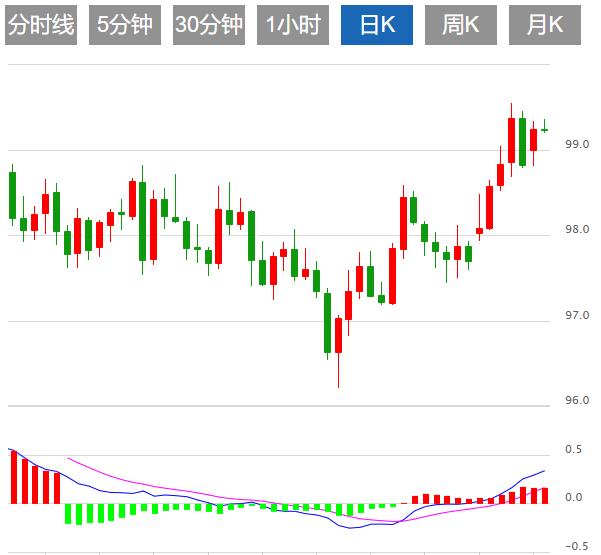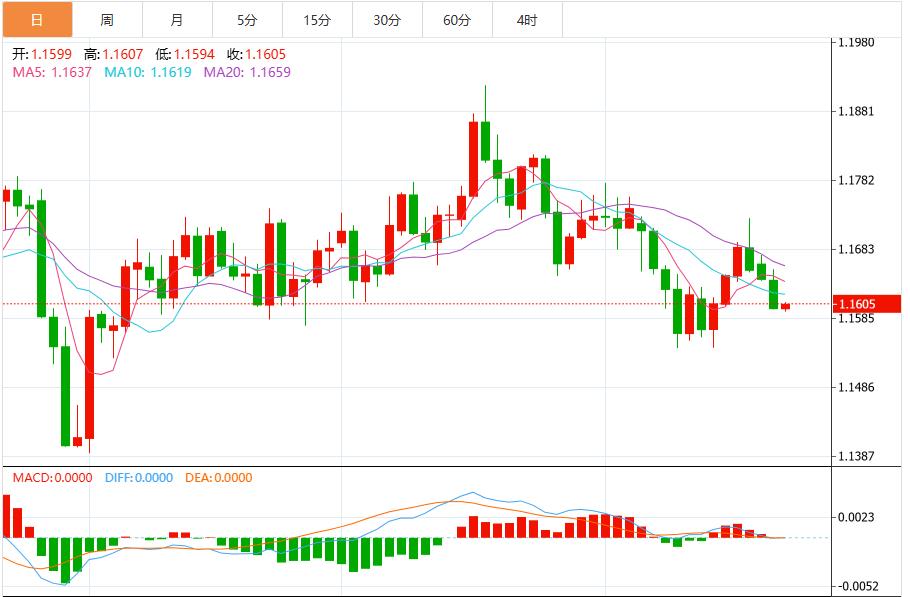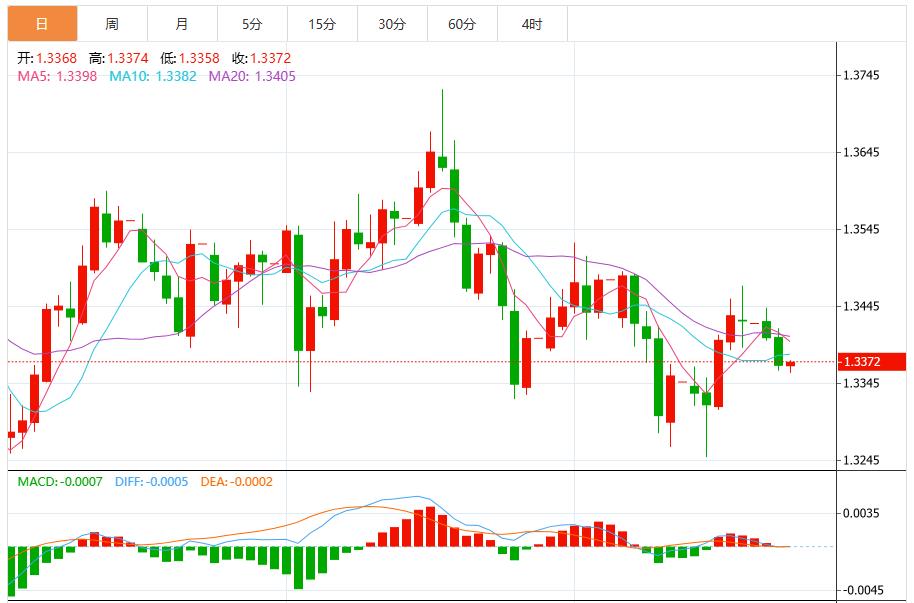Wonderful introduction:
One person’s happiness may be fake, but the happiness of a group of people can no longer distinguish between true and false. They squandered their youth to their heart's content, wishing they could burn it all away. Their posture was like a carnival before the end of the world.
Hello everyone, today XM Forex will bring you "[XM Forex]: The U.S. dollar index fluctuates below the 99 mark, and the market is waiting for U.S. inflation data." Hope this helps you! Original content is as follows:
The dollar index hovered around 98.89 in Asian trading on Friday. The dollar rose against the yen on Thursday as traders awaited U.S. consumer inflation data postponed to Friday and weighed the impact of new U.S. sanctions on Rosneft. The sanctions have boosted oil prices. The data will remain closely watched even as the Fed's policymaking focus shifts from inflation to U.S. labor market conditions.
USD: The US dollar edged higher on Thursday as traders adjusted positions for Friday's delayed Consumer Price Index (CPI) report, while geopolitical risks from escalating trade tensions heated up again. The U.S. dollar has seen the most significant gains against the Japanese yen, which has continued to weaken recently due to Japan's domestic political dynamics and fading policy optimism. Technically, the U.S. Dollar Index (DXY) has successfully tested the 50-day moving average (currently at 98.094), a level that held on Friday, with price action confirming it as short-term support. Previously, the U.S. dollar index broke through early resistance levels such as 98.238, 98.714 and 98.797. Now these points have been transformed into layered support levels. The upward path opens the possibility of a test of the October 9 swing high of 99.563. Traders are waiting for a catalyst, possibly Friday's CPI data, to confirm bulls continue the trend. If the CPI data is in line with or higher than expected, it may push the U.S. dollar index further upward toward this technical target.



U.S. Treasury Secretary Scott Bessent confirmed that the United States may impose software export restrictions on China. After the market digested this statement, U.S. Treasury bond yields rose slightly: the 10-year Treasury bond yield rose to 3.995%, and the 2-year and 30-year Treasury bond yields also increased. If the trade tensions between China and the United States further escalate, it may curb risk appetite and strengthen the market's safe-haven demand for the U.S. dollar.
The market is paying close attention to the CPI data rescheduled for release on Friday in order to obtain clues about the momentum of the U.S. economy. The report, delayed by the government shutdown, will not only provide the basis for Social Security cost-of-living adjustments, but could also affect short-term market sentiment - even as the Fed turns its attention to labor market health. Economists predict that the overall CPI monthly increase in September is 0.4%, and the core CPI monthly increase is expected to be 0.3%; year-on-year, the increase in both indicators is expected to be 3.1%. Analysts pointed outOngoing inflationary pressures stem from tariff-driven pricing of goods, particularly in apparel and furniture, but falling mortgage rates are seen as a mitigating factor that should lower housing costs and curb overall inflation.
On October 23, local time, Russian President Vladimir Putin said in an interview with the media that the new sanctions imposed by the United States on Russia are intended to put pressure on Russia, but will not have a major impact on the Russian economy. Putin said that in view of the current situation, the US president decided to cancel or postpone the meeting. More precisely, Trump said that the meeting was postponed. Putin reiterated that dialogue is always better than any form of confrontation and even better than war. Therefore, Russia has always advocated the proposal of dialogue, and this position has not changed to this day.
British consumer confidence recorded -17, climbing to the highest level since August 2024. The main driver is consumers taking advantage of promotions on Amazon and other major retailers for shopping. Neil Bellamy, consumer director at GfK, said: "This rise has been driven in part by promotions from major retailers, as savvy consumers have adapted their buying strategies to get the most out of their money after years of high inflation. The pick-up in overall confidence data belies the impact on individuals Growing financial anxiety. While households' assessment of the overall economic situation has improved, their outlook for their own financial situation in the ew15.cning year has worsened. "This pessimism may be related to high savings rates and expectations of further tax increases by Chancellor Reeves in the annual budget on November 26." Analyst Eamonn Sheridan said the report undermined optimistic expectations for a strong recovery in retail and was likely to continue to weigh on the pound as it reinforced the view that households were preparing for financial tightening, which could dampen consumption even during the upcoming critical "Black Friday" period.
Annabel Fiddes, deputy director of economics at S&P Global Market Intelligence, said: "Japanese PMI data showed that the growth momentum of the private sector further weakened in October. The manufacturing industry is still stuck in a continued decline, and the latest survey shows that factory orders fell at the fastest rate in 20 months amid reports of weak customer demand and a relatively sluggish business environment. No. However, manufacturers are more optimistic than service providers about the outlook for the year ahead, with many hoping that recovering global economic conditions, new product launches and strong demand for areas such as electronics will help boost output. At the same time, prices continue to show continued inflationary pressures in Japan. Input costs and output expenses are increasing at a historically strong rate, which ew15.cnpanies attribute to higher employment costs, raw material and fuel costs, and a weak yen. ”
Strategists at JPMorgan Chase and Bank of America predict that the Federal Reserve will stop shrinking its balance sheet of approximately US$6.6 trillion this month, and this process aimed at draining liquidity from the financial market will end early. Both banks have advanced their forecasts for the end of quantitative tightening by the Federal Reserve due to the recent increase in borrowing costs in the U.S. dollar financing market. They had previously expected that the balance sheet reduction started in June 2022 will continue until December or early next year. The market generally expects Fed officials to decide on the direction of the balance sheet at next week's interest rate decision. Although a 25 basis point rate cut is seen as a high probability event, Wall Street remains divided on when policymakers will end quantitative tightening. Institutions such as TD Securities and Mizuho Securities have advanced their forecasts to October, while analysts at Barclays and Goldman Sachs believe the end time will be later.
ew15.cnmerzbank analyst Michael Pfister pointed out in a research report that the foreign exchange market is currently showing indifference to the new round of U.S. tariff threats. He believes this may be due to the fact that the market has gradually become desensitized to tariff measures, or that the impact of tariffs has been fully priced in. It is worth noting that tariffs are continuing to push up U.S. inflation expectations, which means that the market has difficulty pricing in further space for the Federal Reserve to cut interest rates, while interest rate cut expectations in other countries have also stabilized. Although the current trade data only shows a slight impact, Pfister emphasized that "this does not mean that tariffs have not had an impact, the impact may just take longer to be apparent."
JP Morgan analyst Junya Tanase pointed out in a research report that the recent market reduction in expectations for the Bank of Japan’s interest rate hike at this month’s meeting may be excessive, and the yen is expected to resume its upward trend. Although Sanae Takaichi's election as leader of the ruling party has fueled market expectations for easing policy, the Bank of Japan's policy guidance has not changed, and an interest rate hike on October 30 is still within the possibility. The bank predicts that if the Bank of Japan decides to raise interest rates next week and its policy ew15.cnmunication pushes up terminal interest rate expectations, the USD/JPY exchange rate may fall to 142.00 by the end of the year (currently trading around 152.60). Tanase added: "If the above conditions are not met, it may be necessary to increase the US-Japan exchange rate expectations."
The above content is about "[XM Foreign Exchange]: The US dollar index fluctuates below the 99 mark, the market is waiting for US inflation data". It was carefully ew15.cnpiled and edited by the editor of XM Foreign Exchange. I hope it will be helpful to your trading! Thanks for the support!
Due to the author's limited ability and time constraints, some contents in the article still need to be discussed and studied in depth. Therefore, in the future, the author will conduct extended research and discussion on the following issues: